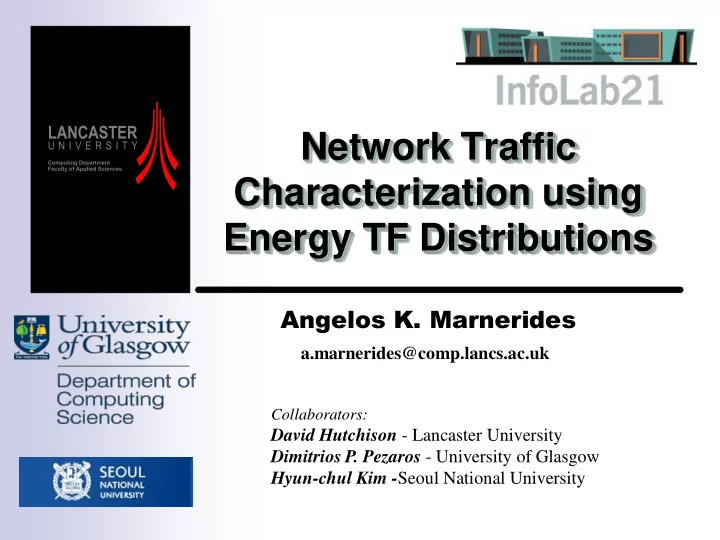

Network Traffic Characterization using Energy TF Distributions Angelos K. Marnerides a.marnerides@comp.lancs.ac.uk Collaborators: David Hutchison - Lancaster University Dimitrios P. Pezaros - University of Glasgow Hyun-chul Kim - Seoul National University
Computing Computing department department Outline Motivation Approach Data & Features Results Summary On-going & Future Work
Computing Computing department department Importance of Traffic Characterization & Classification Weakness of manual inspection by NOCs Pre-requisite for understanding the fluctuant network behavior Foundational element for Traffic Engineering (TE) tasks: - cost optimization ,efficient routing, congestion management, availability, resilience, anomaly detection, traffic classification etc.. Application-based traffic Classification : a necessity - net neutrality debate, ISPs vs. Content providers - emergence of new applications, attacks etc.. - file sharing vs. intellectual property representatives
Computing Computing department department Motivation Traffic modeling assumptions not thoroughly investigated - Stationarity? Rapid growth of new Internet technologies and applications. Essence for new and adaptive traffic classification features.
Computing Computing department department Approach Volume-based analysis on real pre-captured network traces for characterizing the traffic’s dynamics. Validation of stationarity under TF representations - Instantaneous frequency and group delay for stationarity. Volume decomposition for revealing protocol-specific dynamics and classify the volume-wise utilization (#bytes and #pkts) of the transport layer. Provision of application-layer characteristics based on the level of signal complexity using the Cohen-based Energy TF Distributions.
Computing Computing department department Data & Features 2 30min full pcap traces from a Gb Ethernet Link at Keio University, Japan (Keio-I, Keio-II) - extracted # of bytes & pkts for each unidirectional flow for TCP,UDP, ICMP Hour-long full pcap trace from a US-JP link (WIDE) 100 Mbps FastEthernet link (SamplePoint B – MAWI Working group) - divided in 4, 13.75-min bins (WIDE-I,WIDE-II,WIDE- III,WIDE-IV) -employed the same feature extraction as in Keio-I/II
Computing Computing department department Data & Features (tables) * Kim et al. L., Internet traffic classification demystified: myths, caveats, and the best practices , ACM CoNEXT 2008
Computing Computing G a G a G a ( t ( t ( t ) ) ) 1 1 d d arg arg G G ( ( ) ) a a X X ( ( ) ) G G 2 2 d d department department Stationarity Test A signal is stationary if the elements in its analytical form keep a constant instantaneous frequency and group delay respectively. G a ( t ) Process g(t) (counts of bytes/packets), and its analytical form ( after applying a Hilbert transformation and the Fourier F ) a transform of G a ( t ) d arg G ( t ) 1 a f ( t ) • Instantaneous Frequency 2 dt - f(t): amplitude of frequency we observe in 1 count of a packet/byte arrival at time t 1 d arg F ( ) a t ( ) G • Group Delay 2 d ( : time distortion caused by the signal’s instantaneous - t ) G frequency
Computing Computing department department Stationarity analysis Validation of instantaneous frequency and group delay’s behaviour in all datasets. Investigated stationarity on ithe original and differentiated traffic signal Conclusion : traffic in all traces is highly non-stationary and has the form of a multi-component signal (for all protocols).
Computing Computing department department Stationarity analysis (results) After 3 rd order differentiation Before differentiation
Computing Computing 1 1 1 1 1 1 j j WV WV ( ( t t , , ) ) s s * * ( ( t t ) ) e e s s ( ( t t ) ) d d 2 2 2 2 2 2 department department Traffic Classification with Cohen- based Energy TF distributions Suitable for characterizing highly non-stationary signals as the volume dynamics of the transport layer. - Overcome limitations by other techniques (e.g. STFT, Wavelets) on the TF plane with respect to TF localization and resolution Particularly used *: -Wigner-Ville (WV) Distribution -Smoothed Pseudo Wigner-Ville (SPWV) Distribution - Choi-Williams (CW) Distribution Employment of Renyi Dimension for determining signal complexity (i.e. volume-wise intensity) on the TF plane – used as the classification discriminative feature Simple Decision tree- based classification using MATLAB’s classification utility functions Definitions provided in : Cohen, L., Time-Frequency Distributions: A Review, Proc IEEE Signal Processing, Vol. 77, 1989
Computing Computing department department Classification Performance Metrics Accuracy per-trace # correcty _ classified _ flows Accuracy # total _ flows _ per _ trace Per-Application - Recall : “How complete is an application fingerprint?” True _ positives Re call True _ positives False _ negatives
Computing Computing department department Pre-processing for Traffic Classification Extensive port and host-behaviour-based approach Usage of graphlets from BLINC
Computing Computing department department Pre-processing for Traffic Classification (cont..) Keio-I : training set , Keio-II : test set Computation of each energy distribution for every application protocol individually based on the packet and byte-wise utilization of TCP & UDP. Comparison between distributions. Extraction of the Renyi Dimension for every application protocol from the selected TF distribution.
Computing Computing department department Comparison of energy TF distributions (example : Keio TCP bytes for MSN)
Computing Computing department department Results (example: Classification of TCP bytes for Keio trace - SPWV )
Computing Computing department department Results (cont) Overall Accuracy Traffic Cat. Recall% Recall% (bytes) (pkts) Keio trace : 95%(pkts) WWW >=90.4% >=95.8% 93%(bytes) FTP >=94.5% >=97.3% P2P >=84.8% >=91.9% WIDE trace : 92% (pkts) DNS >=95.6% >=98.6% 88% (bytes) Mail/News >=93.3% >=97.8% Streaming >=81.3% >=92.2% Net. Ops. >=96.8% >=94.1% Encryption >=95.3% >=89.8% Games >=89.3% >=93.9% Chat >=82.1% >=92.7% Attack >=78.9% >=88.6%
Computing Computing department department Summary Backbone and Edge network link traffic is highly non-stationary. Suitability of Energy TF distributions for general traffic profiling. Practical usability presented particularly in the area of traffic classification. Introduction of complexity-based traffic classification based on the 3 rd order Renyi Dimension. Packet-based analysis indicated higher accuracy .
Computing Computing department department On going &Future Work New network-oriented features (e.g. 5 tuple) New Energy TF metrics (e.g. 1 st , 2 nd order moment sequence) Employment of Support Vector Machines. Full, comparison with BLINC on larger datasets. Thank you
Recommend
More recommend